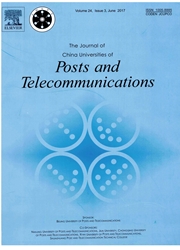

 中文摘要:
中文摘要:
在这份报纸,线性基于漏的 precoders 的设计被考虑为多重输入多重产量(MIMO ) downlinks。我们的建议计划最小化总数在每个用户的 signal-to-leakage-plus-noise 比率(SLNR ) 下面播送力量限制。当基础车站知道完美的隧道状态信息(CSI ) 时,设计问题的合适的重新阐述允许 semidefinite 的成功的申请松驰(SDR ) 技术。当基础车站与有限评价错误知道有瑕疵的 CSI 时,设计问题能用 semidefinite 节目(SDP ) 被解决。同时,它能动态地根据每个用户的隧道状态分配每个用户的 SLNR 阀值,因此它比另外的类似的基于 SINR 的 precoding 方法更可行。用大 SLNR 阀值,建议设计更好举办的模拟结果表演在高 signal-to-noise 比率(SNR ) 比 maximal-SLNR precoding 方法咬了错误率(BER ) 性能。而且当基础车站知道有瑕疵的隧道状态信息时,建议 precoder 对隧道评价错误柔韧,并且比另外的类似的基于 SINR 的 precoding 方法有更好的 BER preformance。
 英文摘要:
英文摘要:
In this paper, the design of linear leakage-based precoders is considered for multiple-input multiple-output (MIMO) downlinks. Our proposed scheme minimizes total transmit power under each user's signal-to-leakage-plus-noise ratio (SLNR) constraint. When the base station knows perfect channel state information (CSI), suitable reformulation of design problem allows the successful application of semidefinite relaxation (SDR) techniques. When the base station knows imperfect CSI with limited estimation errors, the design problem can be solved using semidefinite program (SDP). At the same time, it can dynamically allocate each user's SLNR threshold according to each user's channel state, so it is more feasible than other similar S1NR-based precoding methods. Simulation results show that using large SLNR thresholds, the proposed design has better bit error rate (BER) performance than maximal-SLNR precoding method at high signal-to-noise ratio (SNR). Moreover, when the base station knows imperfect channel state information, the proposed precoder is robust to channel estimation errors, and has better BER preformance than other similar SINR-based precoding methods.
 同期刊论文项目
同期刊论文项目
 同项目期刊论文
同项目期刊论文
 Comparisons Between Reliability-Based Iterative Min-Sum and Majority-Logic Decoding Algorithms for L
Comparisons Between Reliability-Based Iterative Min-Sum and Majority-Logic Decoding Algorithms for L 期刊信息
期刊信息
